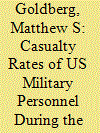| Srl | Item |
| 1 |
ID:
160093


|
|
|
|
|
| Summary/Abstract |
In Operation Iraqi Freedom, which ended in August 2010, nearly 3500 hostile deaths occurred among US military personnel and 32,000 more were wounded in action (WIA). More than 1800 hostile deaths occurred during Operation Enduring Freedom (in and around Afghanistan) through 2014 and about 20,000 were WIA. A larger proportion of wounded personnel survived in Iraq and Afghanistan than during the Vietnam War, but the increased survival rates were not as high as some studies have asserted. The survival rates were 90.2% in Iraq and 91.6% in Afghanistan, compared with 86.5% in Vietnam. The casualty rates varied between the conflicts in Iraq and Afghanistan and before, during, and after the respective surges. Amputation rates are difficult to measure consistently, but I estimate that 2.6% of all WIA and 9.0% of medically evacuated WIA from the Iraq and Afghanistan theaters combined resulted in the major loss of a limb. Elevated non-hostile death rates (including deaths due to accidents, illnesses, homicides, or suicides) resulted in about 220 more deaths in Iraq and about 200 more deaths in Afghanistan than would have been expected in peacetime among populations of the size deployed to those two conflicts.
|
|
|
|
|
|
|
|
|
|
|
|
|
|
|
|
| 2 |
ID:
167881


|
|
|
|
|
| Summary/Abstract |
Studies analyzing the popularity of American presidents consistently find that even though casualties drag down approval rates over time, there is a temporarily positive effect in the beginning of the mission (also known as the rally effect). Are these findings generalizable to other advanced industrial Western democracies? This latter question has not yet been answered convincingly because of two issues: studies are either (1) limited to high profile cases (such as the Iraq War) or (2) based on US data only. I examine the effect of rising or falling military casualties on the change in the popularity of governing parties for ten OECD countries using a novel dataset that comprises monthly polling and economic data for these ten countries in the post–Cold War period. My analyses show that governing parties benefit from an increase in military casualties for at least a year but get punished from 4.5 years into the intervention.
|
|
|
|
|
|
|
|
|
|
|
|
|
|
|
|